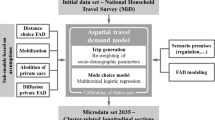Zusammenfassung
Today, vehicle concepts are developed on the basis of technical design premises derived from attributes such as e.g. the electrical range in the case of electrified vehicles. For the respective positioning of the concept, the customer requirements of the relevant target group determined by market research and the competitive comparison are decisive. Technological trends (e.g. fully automated driving1; FAD) and business model innovations (e.g. on demand mobility; ODM) have the potential to change the mobility behavior of users and thus the characteristics of vehicle concepts.
Access this chapter
Tax calculation will be finalised at checkout
Purchases are for personal use only
Preview
Unable to display preview. Download preview PDF.
Similar content being viewed by others
Literatur
1. Achleitner A, Antony P, Berger E et al (2016) Formen und neue Konzepte. In: Pischinger S, Seiffert U (eds) Vieweg Handbuch Kraftfahrzeugtechnik. Springer Fachmedien Wiesbaden, Wiesbaden, pp 131–251
2. ADAC (2018) ADAC Info - Autodatenbank Markenauswahl. https://www.adac.de/infotestrat/autodatenbank/autokatalog/default.aspx. Accessed 1 October 2018
3. Baumgartner M (2018) Entwicklung von Lösungsansätzen für Innenraumkonzepte in vollautomatisierten zukünftigen Fahrzeugkonzepten. Master’s thesis. Technische Universität München
4. Cornett AP (2002) Plattformkonzepte in der Automobilentwicklung. Zugl.: Koblenz, Wiss. Hochsch. für Unternehmensführung, Diss., 2000. 1st edn. Dt. Univ.-Verl., Wiesbaden
5. Follmer R, Gruschwitz D, Jesske B, Quandt S (2010) Mobilität in Deutschland 2008: Ergebnisbericht: Struktur – Aufkommen – Emissionen – Trends. Bundesministeriums für Verkehr, Bau und Stadtentwicklung
6. Hensher DA, Button KJ (2007) Handbook of Transport Modelling. 2nd edn. Emerald Group Publishing Limited; Turpin Distribution Services Limited [distributor], Bingley, Biggleswade
7. Kampker A, Gerdes J, Schuh G (2017) Die StreetScooter-Mobilitätslösung. In: Kampker A, Gerdes J, Schuh G (eds) Think Big, Start Small: StreetScooter die e-mobile Erfolgsstory: Innovationsprozesse radikal effizienter. Springer Berlin Heidelberg, Berlin, Heidelberg, pp 201–210
8. KBA (2014) Korrigierte Endfassung 11. KBA-Bekanntmachung zur Fahrzeugsystematik (SV 1). Kraftfahrt-Bundesamt
9. Kröger L, Kuhnimhof T, Trommer S (2016) Modelling the Impact of Automated Driving. Private AV Scenarios for Germany and the US. Presented to the European Transport Conference. German Aerospace Center, Berlin
10. Kröger L, Kuhnimhof T, Trommer S (2018) Does context matter? A comparative study modelling autonomous vehicle impact on travel behaviour for Germany and the USA. Transportation Research Part A: Policy and Practice. https://doi.org/10.1016/j.tra.2018.03.033
11. Ortúzar JdD, Willumsen LG (2011) Modelling transport. 4th edn. Wiley, Chichester u.a.
12. Pfriem M (2016) Analyse der Realnutzung von Elektrofahrzeugen in kommerziellen Flotten zur Definition einer bedarfsgerechten Fahrzeugauslegung. Dissertation. Karlsruher Institut für Technologie (KIT)
13. Schneider A (2006) Die strategische Planung des Produktportfolios bei Automobilherstellern: Konzeption eines Instruments zur Bewertung des Cycle-Plans. 1st edn. Nomos, Baden-Baden
14. Tesch F (2010) Bewertung der Strukturvariabilität von Pkw-Karosseriederivaten. Dissertation. Technische Universität München
15. Trommer S, Kolarova V, Fraedrich E, Kröger L, Kickhöfer B, Kuhnimhof T, Lenz B, Phleps P (2016) Autonomous Driving: The Impact of Vehicle Automation on Mobility Behaviour. ifmo - Institute for Mobility Research
16. Ulrich K (1995) The role of product architecture in the manufacturing firm. Research Policy 24:419–440. https://doi.org/10.1016/0048-7333(94)00775-3
17. VDA (2015) Automation: From Driver Assistance Systems to Automated Driving. Verband der Automobilindustrie e. V. (VDA)
Author information
Authors and Affiliations
Editor information
Editors and Affiliations
Rights and permissions
Copyright information
© 2019 Springer Fachmedien Wiesbaden GmbH, ein Teil von Springer Nature
About this paper
Cite this paper
Peters, P.L., Demuth, R., Schramm, D. (2019). Evaluation of the effects of trends on vehicle concepts based on a forecast of travel demand. In: Bargende, M., Reuss, HC., Wagner, A., Wiedemann, J. (eds) 19. Internationales Stuttgarter Symposium . Proceedings. Springer Vieweg, Wiesbaden. https://doi.org/10.1007/978-3-658-25939-6_46
Download citation
DOI: https://doi.org/10.1007/978-3-658-25939-6_46
Published:
Publisher Name: Springer Vieweg, Wiesbaden
Print ISBN: 978-3-658-25938-9
Online ISBN: 978-3-658-25939-6
eBook Packages: Computer Science and Engineering (German Language)




